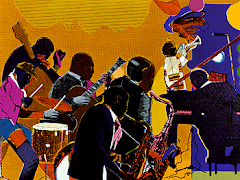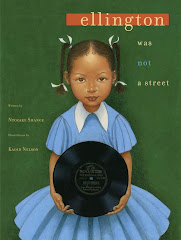

I am from Cote d’Ivoire in West Africa. I am from the Baoule group which is a subgroup of the Akan people. If you know anything about Akan people, you know what great weavers they are. My house in Abidjan was full of weaved covers from my grandfather’s village.
My mother, who is American, had many Liberian friends while we lived in Cote d’Ivoire. Many of these Liberians were descendants of the African-American slaves who left the United States in the 1800’s and founded the country of Liberia. These former African-American slaves brought to Liberia their traditions, even the tradition of quilting and the tradition of passing the art of quilting down to another generation. So, the many Liberian refugees who were fleeing a civil war in their home came to Cote d’Ivoire with the skill of quilting. My mother had a friend, Mr. William, who made quilts for all of our beds in Abidjan. You could give him any design and he could do.
When I recently visited the Philadelphia Museum of Art to see its new exhibition, Gee’s Bend; The Architecture of the Quilt, I saw Africa. For us art is not art for its own sake. It’s functional. We wear it. We use it to keep our bodies warm. We use it to shield ourselves from the elements. We teach lessons of morals and history through it. And it just so happens what we create is absolutely, incredibly beautiful. The equally beautiful women, who created the quilts on display, used old clothing-jeans, cotton, and corduroy and looked at their physical environment and found inspiration from it and created these awesome quilts. Seventy-five of these quilts are on display at the museum until December.
I had the honor to meet some of the quilters from Gee’s Bend, Alabama, at the museum. Most of them learned how to quilt by watching their older family members quilt. They were great-grandmothers who had passed down their quilting knowledge to their children and grandchildren. They are highly intellectual women who believe the Lord sent them to do this work. You could tell these ladies felt uncomfortable being referred to as artists because what they do, like we do in many African countries, is create not for glory and applause, but because we have to- for survival.
The quilters from Gee’s Bend also have amazing voices. During the Philadelphia Museum of Art’s gala reception, these lovely ladies sang for us. It was truly touching. You could tell that their singing, like their quilt-making, belonged to their community.
I urge all my readers to tell your parents, grandparents and other family members about this amazing exhibition-Gee’s Bend; The Architecture of the Quilt. It will be at the Philadelphia Museum of Art until December 14, 2008.
Each week I will post a story related to events and programs connected to this exhibition as well as other quilting-related topics. I would like to thank the Philadelphia Museum of Art who showed amazing faith in me and allowed me to cover this exhibition as a member of the press. I want to give thanks to anyone who supported or sponsored Gee’s Bend and give thanks to the many people who believed in them!
* THE PHOTO ABOVE IS OF ARLONZIA PETTWAY, A GEE'S BEND QUILTER
My mother, who is American, had many Liberian friends while we lived in Cote d’Ivoire. Many of these Liberians were descendants of the African-American slaves who left the United States in the 1800’s and founded the country of Liberia. These former African-American slaves brought to Liberia their traditions, even the tradition of quilting and the tradition of passing the art of quilting down to another generation. So, the many Liberian refugees who were fleeing a civil war in their home came to Cote d’Ivoire with the skill of quilting. My mother had a friend, Mr. William, who made quilts for all of our beds in Abidjan. You could give him any design and he could do.
When I recently visited the Philadelphia Museum of Art to see its new exhibition, Gee’s Bend; The Architecture of the Quilt, I saw Africa. For us art is not art for its own sake. It’s functional. We wear it. We use it to keep our bodies warm. We use it to shield ourselves from the elements. We teach lessons of morals and history through it. And it just so happens what we create is absolutely, incredibly beautiful. The equally beautiful women, who created the quilts on display, used old clothing-jeans, cotton, and corduroy and looked at their physical environment and found inspiration from it and created these awesome quilts. Seventy-five of these quilts are on display at the museum until December.
I had the honor to meet some of the quilters from Gee’s Bend, Alabama, at the museum. Most of them learned how to quilt by watching their older family members quilt. They were great-grandmothers who had passed down their quilting knowledge to their children and grandchildren. They are highly intellectual women who believe the Lord sent them to do this work. You could tell these ladies felt uncomfortable being referred to as artists because what they do, like we do in many African countries, is create not for glory and applause, but because we have to- for survival.
The quilters from Gee’s Bend also have amazing voices. During the Philadelphia Museum of Art’s gala reception, these lovely ladies sang for us. It was truly touching. You could tell that their singing, like their quilt-making, belonged to their community.
I urge all my readers to tell your parents, grandparents and other family members about this amazing exhibition-Gee’s Bend; The Architecture of the Quilt. It will be at the Philadelphia Museum of Art until December 14, 2008.
Each week I will post a story related to events and programs connected to this exhibition as well as other quilting-related topics. I would like to thank the Philadelphia Museum of Art who showed amazing faith in me and allowed me to cover this exhibition as a member of the press. I want to give thanks to anyone who supported or sponsored Gee’s Bend and give thanks to the many people who believed in them!
* THE PHOTO ABOVE IS OF ARLONZIA PETTWAY, A GEE'S BEND QUILTER
* HOUSETOP VARIATIONS BY LORETTA PETTWAY
For more information contact the Philadelphia Museum of Art at
215-763-8100
www.philamuseum.org
215-763-8100
www.philamuseum.org



































